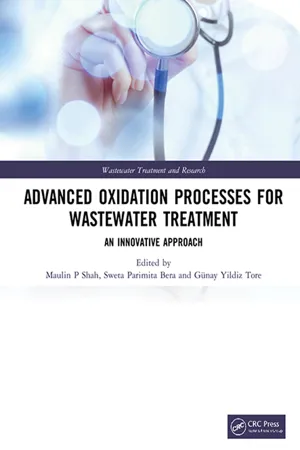
Advanced Oxidation Processes for Wastewater Treatment
An Innovative Approach
- 284 pages
- English
- ePUB (mobile friendly)
- Available on iOS & Android
Advanced Oxidation Processes for Wastewater Treatment
An Innovative Approach
About This Book
Advanced Oxidation Processes for Wastewater Treatment: An Innovative Approach: This book highlights the importance of various innovative advanced oxidation technology to clean up the environment from pollution caused by human activities. It assesses the potential application of several existing bioremediation techniques and introduces new emerging technologies.
This book is an updated vision of the existing advanced oxidation strategies with their limitations and challenges and their potential application to remove environmental pollutants. It also introduces the new trends and advances in environmental bioremediation technology with thorough discussion of recent developments in this field.
This book highlights the importance of different innovative advanced oxidation process to deal with the ever-increasing number of environmental pollutants.
Features:
- Illustrates the importance of various advance oxidation processes in effluent treatment plant
- Points out the reuse of the treated wastewater through emerging advance oxidation technologies for effluent treatment plant
- Highlights the recovery of resources from wastewater
- Pays attention to the occurrence of novel micro-pollutants
- Emphasizes the role of nanotechnology in bioremediation of pollutants
- Introduces new trends in environmental bioremediation
Frequently asked questions
Information
1 Treatment of Industrial Wastewater Utilizing Standalone and Integrated Advanced Oxidation Processes
CONTENTS
- 1.1 Introduction
- 1.2 Advanced Oxidation Processes (AOPs)
- 1.2.1 Ozone Oxidation Process
- 1.2.2 Fenton Oxidation Process
- 1.2.3 Electrochemical Oxidation Process
- 1.2.4 UV Oxidation Process
- 1.2.5 Ultrasound-Based Oxidation Process
- 1.3 Sustainability of Advanced Oxidation Process
- 1.4 Utilization of AOPs in Bioremediation
- 1.5 Integrated Advanced Oxidation Processes
- 1.5.1 Ozone/Hydrogen Peroxide (O3/H2O2) Process
- 1.5.2 Ozone/UV Radiation (O3/UV) Process
- 1.5.3 Ozone/Catalysts Process
- 1.5.4 UV Radiation/Fenton Reagent Process
- 1.5.5 UV Radiation/Hydrogen Peroxide (UV/H2O2) Process
- 1.5.6 Sonolysis/Fenton Process
- 1.5.7 Sonolysis/Ozonation Process
- 1.6 Economical Aspects of Individual and Integrated AOPs
- 1.7 Conclusion and Future Aspects
- References
1.1 Introduction
1.2 Advanced Oxidation Processes (AOPs)
Table of contents
- Cover
- Half Title
- Series
- Title
- Copyright
- Contents
- Preface
- Editor Bio
- List of Contributors
- 1 Treatment of Industrial Wastewater Utilizing Standalone and Integrated Advanced Oxidation Processes
- 2 Electro- and Photo-Fenton-Based Techniques in Wastewater Treatment for Advanced Oxidation of Recalcitrant Pollutants
- 3 Emerging Contaminants
- 4 Application of Advanced Oxidation Processes to Treat Industrial Wastewaters: Sustainability and Other Recent Challenges
- 5 Photoelectrocatalysis: Principles and Applications
- 6 Advanced Oxidation Processes for Wastewater Treatment: Types and Mechanism
- 7 Nanotechnology for Advanced Oxidation Based Water Treatment Processes
- 8 Electron Beam Accelerators: Wastewater to Useable Water
- 9 Insight into Advanced Oxidation Processes for Wastewater Treatment
- 10 Implementation of Progressive and Advanced Oxidation Techniques for the Efficient Treatment of Cytotoxic Effluents
- 11 Advanced Oxidation Processes and Bioremediation Techniques for Treatment of Recalcitrant Compounds Present in Wastewater
- 12 Innovative Advanced Oxidation Processes for Micropollutants in Wastewater
- 13 Application of Advanced Oxidation Processes in Combined Systems for Wastewater Reuse
- 14 Advanced Oxidation Process for Leachate Treatment: A Critical Review
- 15 Recent Trends in Nanomaterial-Based Advanced Oxidation Processes for Degradation of Dyes in Wastewater Treatment Plants
- 16 Advanced Oxidation of Phenolic Pollutants in Wastewater
- 17 Advanced Oxidation Processes for Remediation of Persistent Organic Pollutants
- 18 Treatment of Wastewater and Its Reuse
- 19 Remediation of Metal Pollutants in the Environment
- 20 Treatment Techniques of Industrial Effluents and Wastewater Treatment Plants
- 21 Nanostructured Photocatalytic Materials for Water Purification
- 22 Biological Based Methods for the Removal of VOCs and Heavy Metals